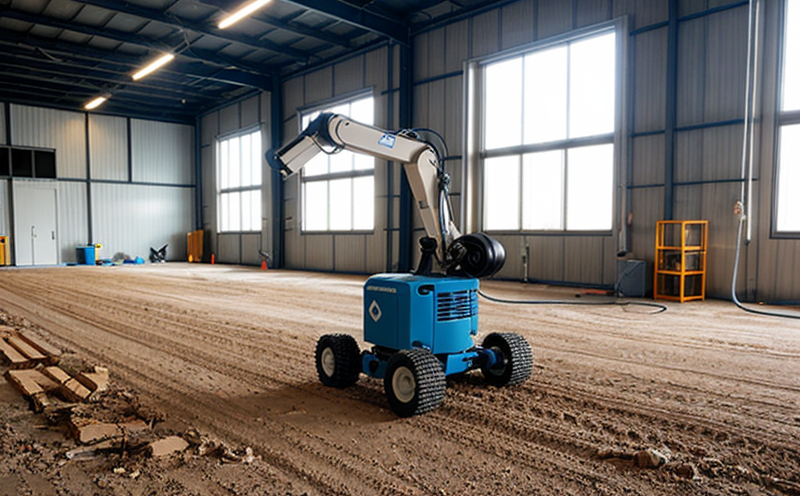IEC 60068-2-30 Humidity Endurance Testing of Robots
The IEC 60068-2-30 standard is a crucial benchmark for ensuring the durability and reliability of robotic systems in harsh environmental conditions. This test evaluates the ability of robots to withstand prolonged exposure to humidity, which can be particularly challenging in various industrial applications such as manufacturing, agriculture, and transportation. The test simulates real-world environments where robots may operate under extreme moisture levels that could compromise their performance.
Understanding the importance of this standard requires a brief overview of its context within the broader robotics industry. Robots are increasingly deployed in outdoor and indoor environments with varying humidity levels. Ensuring they can withstand these conditions is critical for maintaining operational efficiency and longevity, which directly impacts productivity and cost-effectiveness. Compliance with IEC 60068-2-30 not only ensures regulatory adherence but also enhances the reputation of manufacturers by demonstrating a commitment to quality.
The testing protocol involves exposing robotic units to controlled humidity conditions over an extended period. This exposure is designed to mimic actual operating environments where robots are subjected to prolonged moisture. The test parameters include humidity levels, temperature ranges, and duration times that are specified in the standard. Robust specimen preparation is essential; this includes cleaning, drying, and marking specimens before testing begins.
During the test, robotic units undergo continuous monitoring using advanced instrumentation designed for environmental stress testing. This allows for real-time data collection on performance indicators such as electrical resistance changes, mechanical integrity checks, and functional operation assessments. Compliance with IEC 60068-2-30 ensures that robots meet stringent quality standards, which is critical in sectors relying heavily on automated processes.
The acceptance criteria outlined in the standard specify the conditions under which a robotic unit must function without failure to be considered compliant. These criteria are based on industry best practices and reflect real-world operational expectations. By adhering to these standards, manufacturers can ensure their products meet stringent quality benchmarks, thereby enhancing reliability and customer satisfaction.
In summary, IEC 60068-2-30 Humidity Endurance Testing is vital for ensuring the durability of robotic systems in diverse environments. It provides a framework for assessing how well robots perform under prolonged humidity exposure, which can significantly impact their operational efficiency and longevity. Compliance with this standard not only ensures regulatory adherence but also enhances product reliability and customer trust.
Eurolab Advantages
At Eurolab, we pride ourselves on providing comprehensive testing solutions tailored to meet the specific needs of our clients in the robotics sector. Our expertise lies in offering robust IEC 60068-2-30 Humidity Endurance Testing services that ensure high-quality outcomes for robotic systems. Here’s why you should choose us:
- State-of-the-art facilities equipped with advanced instrumentation to accurately simulate real-world conditions.
- Experienced professionals with deep knowledge of robotics and environmental testing standards.
- Dedicated project managers who ensure seamless communication and timely execution of tests.
- A commitment to delivering accurate, reliable test results that meet international standards.
Our services are designed to exceed industry expectations, providing clients with the confidence they need for their robotic systems. With Eurolab, you can rest assured that your products will undergo rigorous testing that aligns with the highest quality benchmarks.
Why Choose This Test
- Regulatory Compliance: Ensures adherence to international standards like IEC 60068-2-30, crucial for regulatory compliance in various sectors.
- Enhanced Reliability: Demonstrates the durability and reliability of robotic systems under challenging environmental conditions.
- Risk Mitigation: Identifies potential issues early, reducing operational risks and maintenance costs.
- Promotes Innovation: Encourages continuous improvement in design and manufacturing processes by highlighting areas for enhancement.
- Better Performance: Ensures that robotic systems operate efficiently and reliably under varying humidity conditions.
- Customer Satisfaction: Builds trust with customers who can rely on products that meet stringent quality standards.
Choosing this test is a strategic investment in the future of your robotics projects, ensuring they are robust, reliable, and capable of meeting real-world demands. It aligns your products with global best practices, enhancing their market competitiveness and overall performance.
Quality and Reliability Assurance
The IEC 60068-2-30 Humidity Endurance Testing plays a pivotal role in the quality assurance process of robotic systems. This test is particularly important because it simulates the environmental stressors that robots may encounter during their operational life cycle. By subjecting robotic units to controlled humidity conditions, we can identify potential weaknesses or failures before they occur in actual use.
One key aspect of this testing involves the detailed preparation and conditioning of specimens prior to exposure to humidity. This ensures that the results obtained are accurate representations of how the robot will perform under real-world conditions. Cleaning, drying, and marking each specimen according to specified protocols is crucial for maintaining consistency in test outcomes.
During the actual testing process, we use sophisticated instrumentation capable of monitoring multiple parameters simultaneously. These include measuring changes in electrical resistance, assessing mechanical integrity, and evaluating functional operation. By collecting real-time data, we can pinpoint any deviations from expected performance early on, allowing for corrective actions to be taken promptly.
The acceptance criteria defined in IEC 60068-2-30 provide clear guidelines on what constitutes a successful test. Compliance with these standards ensures that robotic systems meet stringent quality benchmarks and operate reliably under specified conditions. For instance, the standard specifies permissible limits for changes in electrical resistance or mechanical stress without compromising functionality.
Through rigorous testing, manufacturers can ensure their products not only comply with regulatory requirements but also exceed customer expectations regarding performance and reliability. This commitment to excellence enhances brand reputation and fosters trust among end-users who rely on high-quality robotic solutions across various industries.





